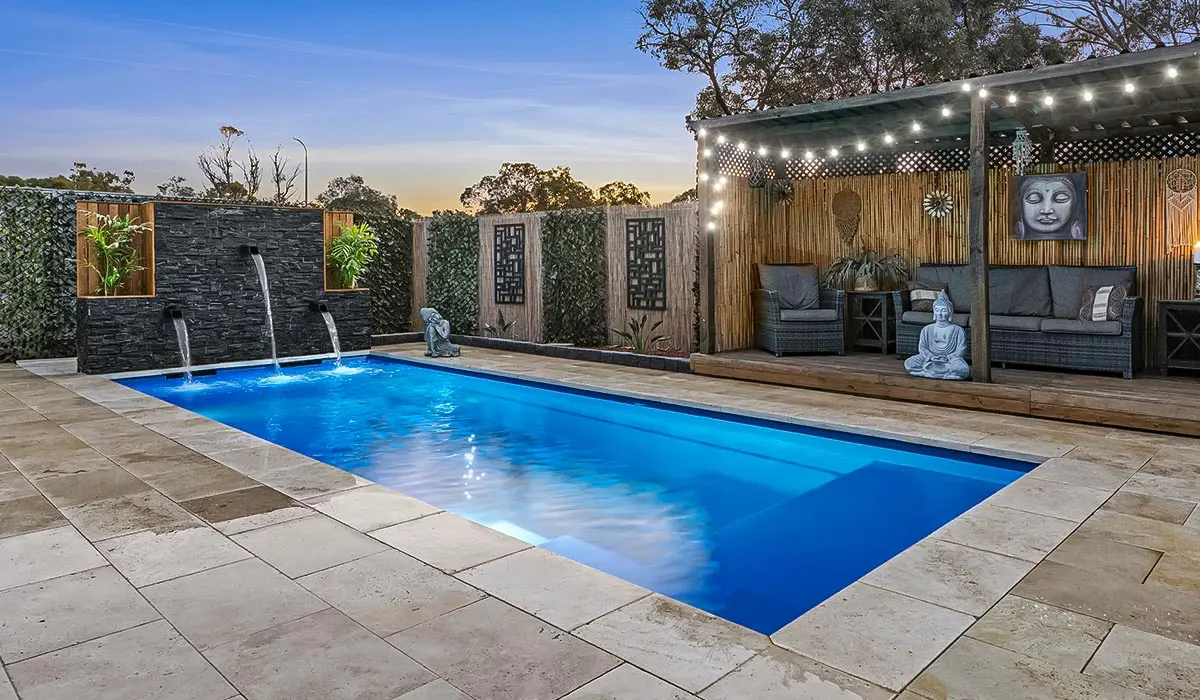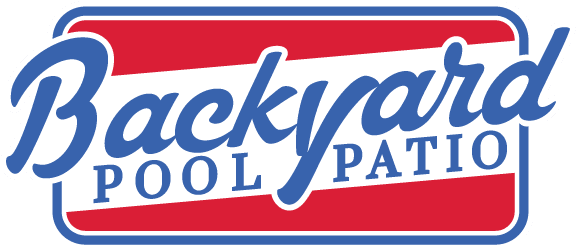
The 4 Most Popular Types of Pool Coping
Pool coping plays a crucial role in both the functionality and aesthetics of a fiberglass pool. It serves as a protective barrier, preventing water from seeping behind the pool shell, while also enhancing the overall appearance of the pool area.
With various coping options available, selecting the right type depends on factors such as budget, maintenance preferences, and design goals. This guide explores the four most popular types of pool coping, detailing their benefits, considerations, and ideal applications.
What Is Pool Coping and Why Is It Important?
Pool coping is the material that caps the edge of a swimming pool, creating a finished look while serving a vital functional purpose. It acts as a protective barrier, preventing water from seeping behind the pool shell and causing structural damage. Without proper coping, water infiltration can lead to issues such as soil erosion, pool shell deterioration, and even shifting of the surrounding deck.
Beyond its protective role, pool coping enhances the overall aesthetics of a fiberglass pool. Available in a variety of materials, textures, and colors, it helps define the pool’s style and seamlessly integrates the water’s edge with the surrounding landscape. From sleek and modern to rustic and natural, the right coping choice can transform a pool into a visually stunning focal point.
Modern pool coping goes beyond mere functionality, offering slip-resistant surfaces for enhanced safety and comfortable materials that remain cool underfoot. Whether opting for concrete, pavers, or natural stone, well-chosen coping elevates both the durability and beauty of a pool, ensuring a long-lasting and enjoyable outdoor space.
1. Cantilevered Concrete Coping
What Is Cantilevered Concrete Coping?
Cantilevered concrete coping is a sleek and seamless option where concrete extends over the edge of the pool shell, creating a smooth, finished look. This method involves pouring concrete over a foam form, which is later removed to reveal a clean, rounded edge. Often featuring a bull-nosed design, cantilevered coping blends effortlessly with surrounding decking materials, making it a versatile choice for modern pools.
Benefits
Cantilevered concrete coping offers a streamlined and contemporary aesthetic, enhancing the pool’s overall design. It’s also one of the most budget-friendly options, with costs ranging from $6 to $10 per linear foot. Its durability makes it a long-lasting choice, and because the concrete is poured in place, it creates a solid bond with the pool deck, reducing movement and shifting over time. Additionally, this coping style works well with a variety of deck materials, from stamped concrete to pavers, ensuring a cohesive backyard design.
Considerations
While cantilevered concrete coping is affordable and visually appealing, achieving a high-quality finish requires skilled installation. Imperfections in the pouring or finishing process can affect the final look, so hiring an experienced professional is essential. Additionally, concrete is porous, meaning it may require periodic sealing to maintain its appearance and prevent staining. Over time, exposure to weather and pool chemicals can lead to minor surface wear, but with proper care, cantilevered concrete coping remains a durable and stylish choice for any fiberglass pool.
2. Paver Coping
What Is Paver Coping?
Paver coping consists of pre-cast concrete pavers, typically designed with bull-nosed edges to create a smooth and comfortable finish around the pool. These pavers can be bonded directly to the fiberglass pool shell or set on a mortar bed, offering flexibility in installation.
Benefits
Paver coping provides a refined, structured look that complements a variety of decking materials, making it a popular choice for homeowners seeking a cohesive design. One of its standout advantages is its modular nature, allowing for the easy replacement of individual pavers if damage occurs—unlike monolithic coping options, which may require extensive repairs.
Additionally, pavers offer excellent durability and customization options. Available in a range of colors, textures, and finishes, they can be selected to enhance both modern and traditional poolscapes. Their non-slip surface also enhances safety, particularly in wet conditions.
Considerations
While paver coping is an attractive and functional choice, it is considered an upgraded option, with costs typically ranging from $40 to $50 per linear foot. This price point reflects the quality of materials and the precision required for installation.
Proper alignment is crucial to achieving a professional finish, so working with an experienced installer is recommended. Additionally, while pavers are highly durable, they may require occasional re-leveling if the underlying base shifts over time.
Overall, paver coping strikes an excellent balance between aesthetics, functionality, and ease of maintenance, making it a worthwhile investment for those looking to enhance their fiberglass pool with a polished and versatile edge.
3. Travertine Coping
What Is Travertine Coping?
Travertine pool coping is made from natural travertine stone, a durable material with a refined, marble-like texture. Known for its luxurious appearance, it enhances the elegance of any pool while providing a strong, long-lasting edge. This high-end option blends seamlessly with a variety of outdoor designs, from classic to contemporary.
Benefits
Travertine coping offers a combination of beauty and functionality, making it a popular choice for pool surrounds. Key benefits include:
- Cool Underfoot: Even in intense sunlight, travertine remains cooler than many other materials, making it comfortable for bare feet.
- Slip Resistance: Its naturally textured surface provides better grip, reducing the risk of slips around the pool.
- Timeless Aesthetic: With soft, earthy tones and organic variations in color, travertine adds depth and character to any poolside space.
- Versatile Design: Complements a wide range of patio materials, seamlessly integrating with different outdoor styles.
Considerations
While travertine is a stunning and durable choice, a few factors are worth noting:
- Higher Cost: As a premium material, travertine typically ranges from $45 to $55 per linear foot.
- Maintenance Needs: Proper sealing and upkeep help protect the stone from moisture absorption and staining.
- Long-Term Investment: Regular care ensures that travertine maintains its elegant finish for years to come.
For those seeking a sophisticated, long-lasting poolside upgrade, travertine pool coping offers a balance of luxury and practicality.
4. Bluestone Coping
What Is Bluestone Coping?
Bluestone pool coping is a premium natural stone that brings a refined, organic look to any pool space. Available in a range of blue-gray hues, as well as warmer earth tones, bluestone offers versatility to complement both classic and contemporary outdoor designs. This durable material is cut into slabs or tiles, providing a clean, elegant transition from the pool edge to the surrounding deck.
Benefits
Bluestone is a popular choice for homeowners who want a balance of aesthetic appeal and practical performance. Its natural texture and slip resistance make it a safe and stylish option for pool areas. Additionally, the stone’s distinct color variations create a one-of-a-kind look, adding depth and character to your outdoor space.
Beyond its beauty, bluestone is known for its durability. It withstands extreme weather conditions, making it an excellent long-term investment for pools in various climates. Whether exposed to intense summer heat or freezing winter temperatures, this stone holds up well with proper care.
Considerations
While bluestone is a high-end material, with costs ranging from $45 to $55 per linear foot, its longevity and visual appeal often justify the expense. To maintain its rich color and finish, sealing is recommended, especially in areas with frequent water exposure or harsh weather conditions. Without sealing, bluestone can develop a natural patina over time, which some homeowners find appealing as it enhances its natural charm.
Additionally, because it is a dense and heavy material, professional installation is advised to ensure a secure and level fit. Proper installation prevents shifting and minimizes the risk of uneven edges, which can affect both safety and appearance.
Bluestone coping offers a timeless and sophisticated touch to any fiberglass pool, making it an excellent choice for those seeking a blend of elegance, durability, and function.
Choosing the Right Coping for Your Fiberglass Pool
Selecting the best pool coping for your fiberglass pool requires balancing aesthetics, budget, and functionality. With so many options available, understanding key factors can help you make a choice that enhances your pool’s design while ensuring long-term durability and ease of maintenance.
Key Factors to Consider
- Budget: Costs vary widely, from the affordability of cantilevered concrete to the premium pricing of natural stone options like travertine and bluestone. Determine how much you’re willing to invest in both installation and future upkeep.
- Aesthetic Preference: Your coping should complement your pool and surrounding deck. For a seamless, modern look, cantilevered concrete is a great choice, while natural stone materials like travertine or bluestone add a timeless, high-end appeal.
- Maintenance Needs: Some materials, such as pavers, allow for easy repairs, while natural stone may require sealing to protect against wear and staining. Consider how much time and effort you’re willing to dedicate to upkeep.
- Safety Features: If slip resistance and heat retention are concerns, opt for materials like travertine, which stays cool underfoot and provides a textured surface for added grip.
Consulting with a Professional
Choosing the right pool coping is an investment in both style and functionality. A professional installer can ensure proper placement, alignment, and sealing, helping you achieve a polished and long-lasting finish. Additionally, working with an expert allows you to explore customization options, ensuring your coping complements your pool’s design and surrounding landscape.
By carefully weighing these factors and consulting with a specialist, you can select a coping material that enhances the beauty, comfort, and longevity of your fiberglass pool.
Final Thoughts
Selecting the right pool coping enhances both the safety and beauty of your pool area. Whether you prefer the affordability of cantilevered concrete, the flexibility of paver coping, the luxury of travertine, or the natural elegance of bluestone, understanding the benefits and considerations of each option will help you make an informed decision.
Beyond aesthetics, practical factors like durability, maintenance, and slip resistance play a crucial role in choosing the best coping for your fiberglass pool. A well-chosen pool coping material not only protects your pool’s structure but also creates a polished, inviting space for relaxation and enjoyment.
For more pool design inspiration and professional advice, contact the experts at Backyard Pool & Patio today!


